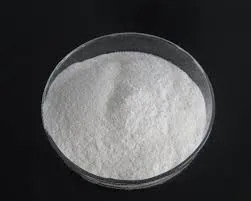
Sep . 19, 2024 03:49 Back to list
hydroxypropyl methyl cellulose cas no
Hydroxypropyl Methyl Cellulose Applications and Benefits
Hydroxypropyl Methyl Cellulose (HPMC) is a versatile cellulose ether derived from natural cellulose, a biopolymer. This compound is characterized by its distinctive chemical structure and its specific properties, which make it an essential ingredient in various industrial applications. The CAS number for Hydroxypropyl Methyl Cellulose is 9004-65-3, making it easily identifiable in chemical databases.
The unique attributes of HPMC stem from its hydroxypropyl and methyl substitution on the cellulose backbone, which significantly enhances its water solubility and thickening capabilities. Its properties include excellent film-forming ability, good binding, and emulsifying characteristics, making it suitable for a wide range of uses in industries including pharmaceuticals, food, cosmetics, and construction.
In the pharmaceutical industry, HPMC plays a crucial role as a binder in tablet formulations, ensuring that active ingredients are properly adhered and providing the necessary mechanical strength to the tablets. Its ability to form gels and control the release of drugs makes it invaluable in controlled-release pharmaceuticals, allowing for a gradual release of medication into the bloodstream. Moreover, HPMC is often used in ophthalmic preparations and as a thickening agent in various solutions, enhancing the viscosity and stability of these formulations.
hydroxypropyl methyl cellulose cas no

In the food industry, Hydroxypropyl Methyl Cellulose serves as a food additive that enhances texture and stability in processed foods. It acts as a thickener, emulsifier, and stabilizer, making it popular in products such as sauces, dressings, and baked goods. HPMC is also appreciated for its ability to retain moisture, helping to improve the shelf-life of food products by minimizing moisture loss and consequently preventing spoilage.
The cosmetic and personal care industries utilize HPMC as a thickening agent, emulsion stabilizer, and film-former in products like lotions, creams, and gels. Its non-toxic and biodegradable nature aligns well with the growing trend towards sustainability in personal care formulations, appealing to eco-conscious consumers.
In construction, HPMC is a crucial component in cement and gypsum-based applications. It enhances the workability, adhesion, and water retention of mortars, plasters, and tiles. This results in improved durability and flexibility of building materials, leading to prolonged life cycles and better performance of construction projects.
In summary, Hydroxypropyl Methyl Cellulose (HPMC) is a multi-functional polymer that significantly influences various sectors. With its diverse applications, from pharmaceuticals to food and construction, it stands out for its effectiveness, safety, and environmental friendliness. As industries continue to seek innovative materials that offer both performance and sustainability, HPMC's role is expected to grow, making it a staple ingredient in formulations across multiple domains. The ongoing research and development surrounding HPMC will likely yield new applications, further solidifying its importance in both current and emerging markets.
-
The Widespread Application of Redispersible Powder in Construction and Building Materials
NewsMay.16,2025
-
The Widespread Application of Hpmc in the Detergent Industry
NewsMay.16,2025
-
The Main Applications of Hydroxyethyl Cellulose in Paints and Coatings
NewsMay.16,2025
-
Mortar Bonding Agent: the Key to Enhancing the Adhesion Between New and Old Mortar Layers and Between Mortar and Different Substrates
NewsMay.16,2025
-
HPMC: Application as a thickener and excipient
NewsMay.16,2025
-
Hec Cellulose Cellulose: Multi functional dispersants and high-efficiency thickeners
NewsMay.16,2025







